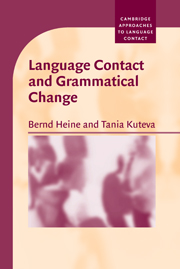Book contents
- Frontmatter
- Contents
- List of maps
- List of tables
- Series editor's foreword
- Preface
- List of abbreviations
- 1 The framework
- 2 On replicating use patterns
- 3 Grammaticalization
- 4 Typological change
- 5 On linguistic areas
- 6 Limits of replication
- 7 Conclusions
- 8 Notes
- References
- Index of authors
- Index of languages
- Index of subjects
Series editor's foreword
Published online by Cambridge University Press: 13 November 2009
- Frontmatter
- Contents
- List of maps
- List of tables
- Series editor's foreword
- Preface
- List of abbreviations
- 1 The framework
- 2 On replicating use patterns
- 3 Grammaticalization
- 4 Typological change
- 5 On linguistic areas
- 6 Limits of replication
- 7 Conclusions
- 8 Notes
- References
- Index of authors
- Index of languages
- Index of subjects
Summary
The series Approaches to Language Contact (ALC) was set up to publish outstanding textbooks and monographs on language contact, especially by authors who approach their specific subject matter from a diachronic or developmental perspective. Our goal is to integrate the ever-growing scholarship on language diversification (including the development of creoles, pidgins, and indigenized varieties of colonial European languages), language convergence, bilingual language development, code-switching, and language endangerment. We hope to provide a select forum to scholars who contribute insightfully to understanding language evolution from an interdisciplinary perspective or by bridging different research areas in linguistics. We favor approaches that highlight the role of the relevant ecology and draw inspiration both from the authors' own fields of specialization and from other disciplines or other research areas in linguistics. Eclecticism is one of our mottos, as we endeavor to comprehend the complexity of evolutionary processes associated with contact.
We are proud to add to the ALC series Bernd Heine and Tania Kuteva's Language Contact and Grammatical Change. This is the first comprehensive monograph that bridges research on grammaticalization with scholarship on language contact and in genetic linguistics. It focuses on linguistic areas, where, because of frequent contacts among their speakers, different languages, some of which are not genetically related, have come to share several structures. The authors propose to identify the language from which a particular structure or function has spread as the model language, and the language calquing it as the replica language.
- Type
- Chapter
- Information
- Language Contact and Grammatical Change , pp. xi - xiiPublisher: Cambridge University PressPrint publication year: 2005



